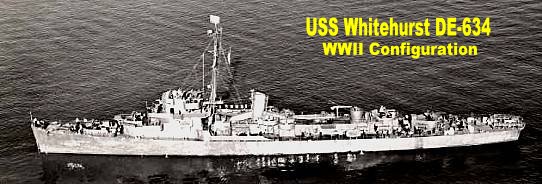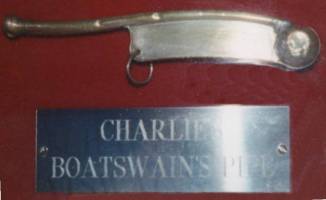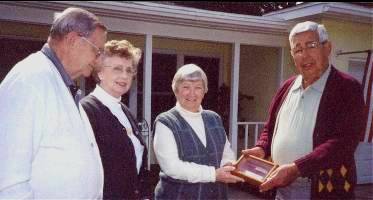
|
Charlie's Pipe |
|
By Roy Graham, Whitehurst Plank owner, WT 3/c and Longtime Reunion Coordinator |
|
|
|
This pipe was used by Boatswains Mate Charles W. Herrill while he served aboard the USS Whitehurst DE-634. Charlie was badly injured, losing a leg, during the Kamikaze attack of 12 April 1945. Some years after the war, Charlie was the main spoke in the wheel that got the Whitehurst reunions rolling. Everyone attending the reunions, that had something from the ship, brought it to show and enhance the memory of serving on the Whitehurst. These mementos were proudly displayed in the hospitality room. Jim Longshore, a Boatswain's Mate himself, and quite a craftsman in civilian life, made the case in which the pipe was displayed. At Jim's death, the pipe was turned over to me, and I took it to the reunions for many years. In 2002, Dottie Herrill, Charlie's widow, contacted me , searching for Charlie's Whitehurst veterans that Charlie had served with. She said it had been many years since she'd heard from any of them. After a phone visit, we agreed on a time for my wife, Ruth, and I to visit her for lunch. Dottie was living in Dunedin, FL, fifty or sixty miles from our winter home in Ruskin, FL. We had not traveled there before so it would be a nice drive. On the day of our visit, Charlie's youngest sister was also there. After a very nice lunch they invited us to see a museum that one of Charlie's sons-in-law had founded. The museum had many mementos from, WWI, WWII guns, and uniforms, Fire Equipment, and other items from earlier times. The museum is only a few years old and is still growing. There are plans in place for building a larger display area. On the way home, I suggested to my wife, that the place for Charlie's pipe was in his son-in-law's museum. She agreed, so at the 2003 reunion, I told those attending about the museum and suggested that the Charlie's pipe belonged there. They all concurred and appointed me to place the pipe in the museum. Last January, Gene Schaab, Whitehurst WWII veteran, was in Florida for a month. During this period, He and I, with my wife and his friend, took the pipe to Dottie and turned it over to her and Charlie's sister, to be placed in the museum where it will be permanently displayed. |
|
|
|
|
|
History of the Boatswain’s Call |
|
Article
from "Military, The Press of Freedom" magazine submitted by |
|
|
|
In the October ‘98 issue of Military, Col. Michael Mark asked readers for their input on the Boatswain’s pipe. Well, it’s taken a while, but we’ve put together this bit of history based on your responses. We thank everyone who responded. The boatswain’s pipe is one of the oldest and most distinctive pieces of personal nautical equipment and was once the only method other than the human voice of passing orders to men on board ship.. Today, more sophisticated communications systems prevail, although the pipe is still used for some ceremonies and to draw attention before MC1 announcements. A pipe or flute was used in the days of antiquity, by which the galley slaves of Greece and Rome kept stroke. There is a record that the pipe was used in the Crusade of 1248 when the English crossbowmen were called on deck to attack by its signal. Shakespeare mentioned the pipe in the Tempest, and Pepys refers to its use in his naval notes. In time, the pipe came to be used as a badge of office; in some cases it was also a badge of honor. The Lord High Admiral carried a gold pipe on a chain around his neck. A silver pipe was used by high commanders as a badge of office, or “whistle of command,” in addition to the gold whistle of honor. The whistle was used for salutes to distinguished personages, as well as to pass orders, and the old instructions read that on most occasions it be blown “three several times.” In the action off Brest on 25 Apr. 1513, between Sir Edward Howard, Lord High Admiral and son of the Earl of Surrey, and the Chevalier Pregant de Bidoux, it is related that when the Lord High Admiral was certain that he would be captured, he threw his gold whistle into the sea. The silver whistle of command was later found on his body. The weight of a standard whistle of honor and names for it’s parts were designated by Henry VIII. The monarch decreed that it should weigh 12 “oons” of gold, and oon being the original ounce. The chain was to be of gold and to have an equivalent in gold ducats, the ducat being an unusual gold coin formerly used in various European countries. About 1671 it was referred to as Call, being known by this in our Navy. Boatswain, pronounced “Bosun,” refers to the mate, warrant officer or petty officer in charge of boats, rigging and ground tackle aboard ship. In Old English the word “swein” meant servant of keeper. The later English term was boat-swayn. In the 17thcentury, British ships were required by law to carry three boats: the boat, the cock and the skiff. The men in charge of them were called boatswains, coxswains and skiffswain. The Boatswain was the officer in charge of rigging, sails and sailing equipment. Men were rigidly trained, almost like sheepdogs, to respond immediately to the piping of the Call -- counted on to hear the high pitched tones of the Call; a shouted order could not be heard in a storm. |
|
The Bosun's Pipe |
|
|
|
Bosun’s Call |
The use of the call eliminates confusion & misunderstanding. There is a call for every activity, such as the hoisting and lowering of boats. cargo, and even burial at sea. Of interest, only the boatswain’s mate is permitted to salute with the left hand, assuming the right hand is used with the call. The call should be held between the index finger and thumb, with the thumb on or near the shackle. The side of the buoy rests against the palm of the hand and the fingers close over the gun and buoy hole in position to throttle the exit of air from the buoy. Most large naval vessels expecting visiting and departing officers have a boatswain’s mate, and eight side boys stationed at the quarterdeck, even in foreign ports. The rank of the officer determines the number of side boys. For example, fleet and vice admirals have eight, a rear admiral, six, a captain or commander, four; a lieutenant commander through ensign have two. In peacetime, side boys are stationed within call of the officer of the deck from 0800 to sunset, except during mess and general drills, to tend the gangway. Seaman second class are usually detailed as side boys. One pipe of the boatswain’s call means two side boys, two pipes, four; three pipes, six, and four pipes, eight. On hearing the pipe, the side boys are to report to the gangway on the double. They are stationed on either side, at attention, to form a passageway. They salute together at the first note of the pipe, and finish the salute together on the last note. The boatswain’s mate gives the order to secure. |
|
The Various Calls and their Meaning: |
To be passed: Piped to command silence before passing an order or information. All hands: Piped to call all hand’s attention; also for calling the first, mid, and morning watches. Boat call: Piped to call away a boat; also to call a division or divisions to quarters. Call mates: Piped by the boatswain to assemble his mates. Stand-by: Piped for set taut, stand-by and lay on. Hoist away: Piped in hoisting boats. In hoisting generally and in the walk away with cat or fish falls; always preceded by the pipe “stand-by.” Haul: Piped to keep men pulling together. Belay: Piped to cease hauling and make fast; and also to cease an order just piped. Heave around: Piped for mess gear; also to heave around a capstan. Veer: Piped to ease away, walk back and slack away. Lay up: Piped to send men aloft. Lay out: Piped to lay out manning yards or rail; also for trice up and out booms. Piping the side: Accompanies appropriate side honors. |
WWII
Era | Korea War &
'50s | Viet Nam & 60s |
Reunions |
All Links Page |
Search & Rescue
Memorial |
Poetry |
Enemy Below |
Taps List |
Photos/Armament |
History |
Crews Index |
Home



